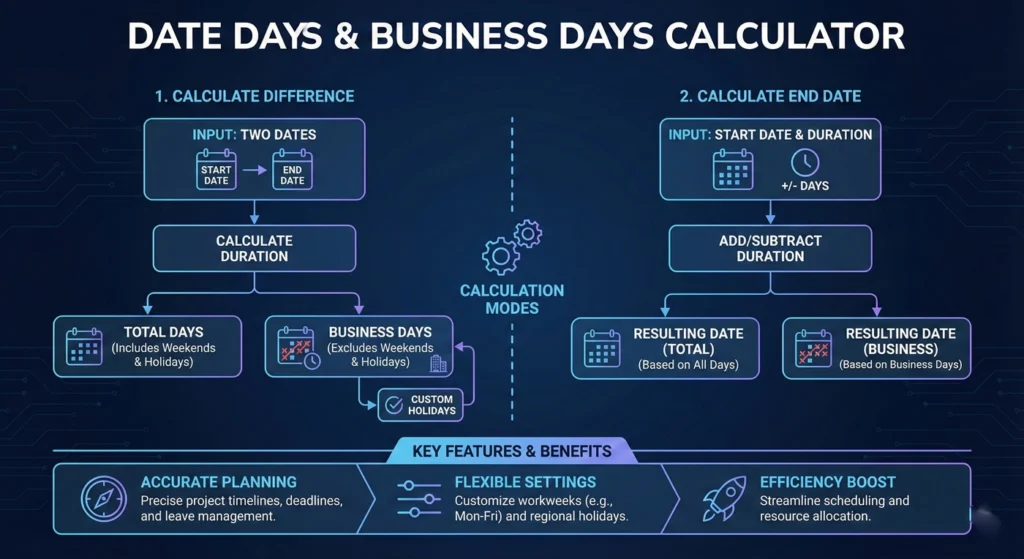Hey there, time warriors! Let’s face it – in today’s crazy-paced world, getting your dates and deadlines right isn’t just helpful, it’s absolutely essential. Whether you’re juggling project deadlines, tracking legal timeframes, or figuring out when that invoice payment is actually due, knowing exactly how many working days you have can make or break your plans.
The big challenge so many of us face? Figuring out how many actual business days fall within a specific timeframe. Sounds simple, right? But once you start excluding weekends, factoring in holidays, and dealing with different country calendars, things get tricky fast!
That’s why I’ve put together this comprehensive guide on Date Days & Business Days Calculators. I’ll walk you through everything from basic definitions to advanced calculation methods (including some cool coding tricks for my tech friends!). By the end, you’ll be a time calculation pro – whether you’re planning projects, setting deadlines, or just trying to figure out when that “10 business days” actually ends.
- Understanding the Core Distinction: Date Days vs. Business Days
- Global & Contextual Definitions of a Business Day
- Professional Calculation Methods and Tools
- Technical Deep Dive: 5 Best Python Functions for Business Days
- Strategic Application and Use Cases
- Financial Services
- Legal & Regulatory Fields
- Project Management
- Human Resources
- Frequently Asked Questions
- Does one business day mean tomorrow?
- How are holidays that fall on a weekend handled?
- What is the average time to reach the top of Google for new content?
- Can a business day calculator account for time zones?
- Conclusion: Harnessing Temporal Intelligence
Understanding the Core Distinction: Date Days vs. Business Days

Before we dive into the nitty-gritty, let’s get super clear on what we’re actually talking about here:
Date Days (Calendar Days) are exactly what they sound like – every single day on the calendar counts. Monday through Sunday, holidays included. No exceptions, no days off. It’s just straight-up chronological time.
Business Days (Working Days), on the other hand, are those days when the professional world is humming along. Typically, these exclude weekends and holidays. Think of them as the days when most offices are open and people are at their desks (or these days, logged in remotely!).
Why does this difference matter so much? Well, imagine your client says they need something “within 10 days.” If they mean calendar days, that’s straightforward. But if they mean business days, you suddenly have two extra weeks to play with! This distinction is HUGE in project management, contract terms, financial operations, and legal compliance.
Global & Contextual Definitions of a Business Day
Here’s where things get interesting (and sometimes confusing)! What counts as a “business day” actually varies depending on where you are and what industry you’re in.
The General U.S. Definition
In the United States, the standard business day typically runs Monday through Friday, 9 am to 5 pm. Federal holidays are excluded – but here’s a twist many people forget: when a holiday falls on a weekend, it’s usually “observed” on the nearest weekday. So if July 4th is a Saturday, most businesses observe Friday, July 3rd as the holiday. A good Date Days & Business Days Calculator needs to account for these shifts!
International Variations
Travel abroad, and things change dramatically. In many Middle Eastern countries like UAE and Saudi Arabia, the workweek runs Sunday through Thursday, with Friday and Saturday being the weekend. Mind-blown, right?
In some countries like India, Colombia, and parts of Mexico, you might find six-day workweeks being the norm, with only Sunday off. Your Date Days & Business Days calculations would look totally different there!
Legal & Financial Definitions
Here’s where it gets super technical (but stay with me, because this stuff matters):
In the U.S. mortgage industry, TRID rules define business days differently depending on the specific requirement. For the three-day waiting period after receiving a Closing Disclosure, “business day” means EVERY day except Sundays and federal holidays listed in 5 U.S.C. 6103(a). That means Saturdays count! Wild, right?
In the securities industry, a business day is simply any day the markets are open for trading. So even if it’s a weird half-day before a holiday, it still counts.
Professional Calculation Methods and Tools

Now that we understand what we’re calculating, let’s talk about HOW to calculate business days without losing our minds.
Online and Professional Calculators
There’s a ton of Date Days & Business Days Calculators online, ranging from super basic to seriously sophisticated:
- Simple Date Counters: These just tell you how many days exist between two dates
- Business Day Calculators: These exclude weekends and holidays based on your country
- API Solutions: For the tech-savvy, these integrate with your own apps and systems
Mastering Spreadsheet Functions
If you’re an Excel or Google Sheets fan, these functions will change your life:
The NETWORKDAYS Function: This beauty calculates working days between two dates, automatically excluding weekends and letting you specify holidays to exclude too. The format is:
Code
=NETWORKDAYS(start_date, end_date, [holidays])
The NETWORKDAYS.INTL Function: This is the international superstar version. It lets you specify which days count as weekends using either a number (1-17) or a seven-character binary string where 1 represents a weekend day and 0 represents a workday. For example:
Code
=NETWORKDAYS.INTL("1/1/2025", "12/31/2025", "0000110")
This example would count Friday and Saturday as weekend days (perfect for Middle Eastern business calculations).
Technical Deep Dive: 5 Best Python Functions for Business Days
For my coding friends out there (or anyone curious about what’s happening behind the scenes in those Date Days & Business Days Calculators), here are five awesome Python approaches:
Method 1: Using numpy.busday_count()
This is super efficient and flexible:
Python
import numpy as np
from datetime import date
start = date(2025, 1, 1)
end = date(2025, 12, 31)
holidays = [date(2025, 1, 1), date(2025, 7, 4)] # New Year's and July 4th
business_days = np.busday_count(start, end, holidays=holidays)
print(f"Business days: {business_days}")
Method 2: Utilizing pandas.bdate_range()
Great if you’re already using pandas for data analysis:
Python
import pandas as pd
from datetime import date
start = date(2025, 1, 1)
end = date(2025, 12, 31)
business_days = len(pd.bdate_range(start, end))
print(f"Business days: {business_days}")
Method 3: Manual Calculation with datetime
The DIY approach using Python’s built-in modules:
Python
from datetime import date, timedelta
def count_business_days(start, end, holidays=[]):
current = start
business_days = 0
while current <= end:
if current.weekday() < 5 and current not in holidays: # 0-4 are Monday to Friday
business_days += 1
current += timedelta(days=1)
return business_days
start = date(2025, 1, 1)
end = date(2025, 12, 31)
holidays = [date(2025, 1, 1), date(2025, 12, 25)]
print(f"Business days: {count_business_days(start, end, holidays)}")
Method 4: Leveraging the workalendar Library
Perfect for international calculations:
Python
from workalendar.usa import UnitedStates
from datetime import date
cal = UnitedStates()
start = date(2025, 1, 1)
end = date(2025, 12, 31)
business_days = cal.get_working_days_number(start, end)
print(f"Business days: {business_days}")
Method 5: The One-Liner with calendar
Quick and dirty for simple cases:
Python
import calendar
from datetime import date, timedelta
business_days = sum(1 for d in range((end - start).days + 1) if (start + timedelta(d)).weekday() < 5)
Comparative Analysis

| Method | Efficiency | Dependencies | Holiday Handling | International Support |
|---|---|---|---|---|
| numpy | High | Medium | Excellent | Good |
| pandas | Medium | Heavy | Good | Good |
| datetime | Medium | None | Manual | Manual |
| workalendar | Medium | Medium | Excellent | Excellent |
| calendar | High | None | None | None |
Strategic Application and Use Cases
So who needs Date Days & Business Days Calculators anyway? Pretty much everyone in business! Here’s how different industries rely on them:
Financial Services
Banks and financial institutions live and die by accurate business day calculations for:
- Payment term calculations (“Net 30” doesn’t mean 30 calendar days!)
- Interest computations (interest typically accrues on business days only)
- Trade settlements (T+2 settlement cycles are based on business days)
- Loan processing deadlines
Legal & Regulatory Fields
The legal world is OBSESSED with deadlines, and most are defined in business days:
- Court filing deadlines (miss one and you could lose your case!)
- Discovery schedules
- Contract durations
- Statutory timeframes for responses
Project Management
Ever worked on a project with tight deadlines? Then you know why business day calculations matter:
- Setting realistic milestones
- Resource allocation based on actual working time
- Managing client expectations (promising delivery in 5 business days vs. 5 calendar days makes a huge difference!)
Human Resources
HR professionals need accurate business day calculations for:
- Leave entitlements
- Probationary periods
- Payroll processing schedules
Frequently Asked Questions
Does one business day mean tomorrow?
Not necessarily! If it’s Friday afternoon and someone says “I’ll get back to you in one business day,” they’re probably talking about Monday. Business days only count workdays, so weekends get skipped in the count.
How are holidays that fall on a weekend handled?
Great question! In most countries, when an official holiday falls on a weekend, it’s observed on the nearest weekday. In the U.S., if the holiday falls on a Saturday, it’s usually observed on the preceding Friday. If it falls on a Sunday, it’s typically observed on the following Monday. A good Date Days & Business Days Calculator needs to account for these shifts.
What is the average time to reach the top of Google for new content?
According to recent data, the average time for a page to reach its top position is about 3.39 months. But honestly? It depends on thousands of factors, including your site’s Domain Rating and Topical Authority. Don’t get discouraged if your Date Days & Business Days content doesn’t immediately shoot to #1!
Can a business day calculator account for time zones?
Most basic Date Days & Business Days Calculators work with full days rather than hours. However, advanced systems designed for international businesses should definitely include time zone awareness. This becomes super important when you’re dealing with same-day deadlines across continents!
Conclusion: Harnessing Temporal Intelligence
We’ve covered a LOT about Date Days & Business Days Calculators – from basic definitions to advanced Python functions and future AI trends. The bottom line? Time calculation isn’t just a technical exercise; it’s a strategic business asset that can help you plan more accurately, stay compliant, and avoid the stress of missed deadlines.
If you’re creating content about Date Days & Business Days Calculators (or any topic, really), remember that good SEO takes time. That 3.39-month average climb to the top of Google isn’t just a random stat – it’s a reminder that quality content needs time to gain traction.
My best tip? Start your link-building efforts about 1.8 months after publishing your content. That’s when your piece has established some initial credibility but can still benefit from the “freshness boost” in search algorithms.
Now go forth and calculate those business days like a pro! Whether you’re planning project timelines, setting payment terms, or just trying to figure out when your package will actually arrive, you’ve got the knowledge you need to master the distinction between Date Days & Business Days.